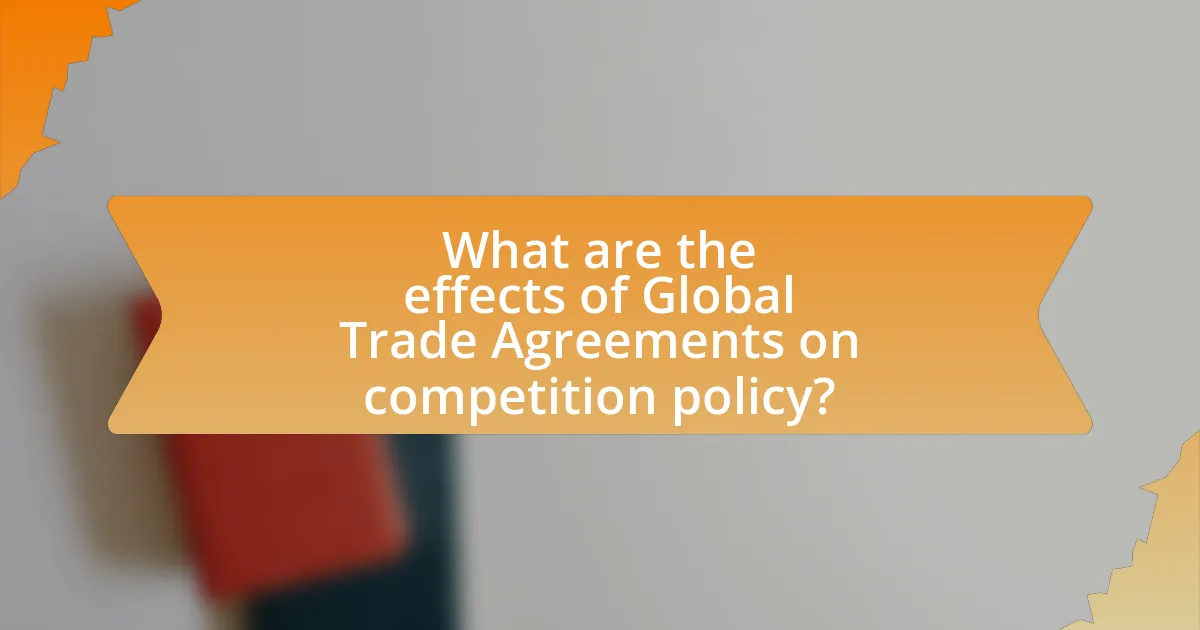Global trade agreements are formal accords between countries that establish rules for trade and economic cooperation, primarily aimed at reducing barriers such as tariffs and quotas. This article examines the impact of these agreements on antitrust legislation, highlighting how they influence international commerce, competition policy, and market dynamics. Key components of global trade agreements, including tariff reductions and investment protections, are discussed in relation to their effects on trade relationships and antitrust enforcement practices. Additionally, the article explores potential conflicts between trade agreements and local antitrust regulations, as well as strategies for aligning these laws to promote fair competition in a globalized market.

What are Global Trade Agreements and Their Purpose?
Global trade agreements are formal accords between countries that establish the rules for trade and economic cooperation. Their primary purpose is to reduce or eliminate barriers to trade, such as tariffs and quotas, thereby facilitating smoother and more efficient exchange of goods and services across borders. For instance, the North American Free Trade Agreement (NAFTA), implemented in 1994, aimed to eliminate trade barriers between the United States, Canada, and Mexico, resulting in increased trade volume among these nations. Such agreements often include provisions that address various aspects of trade, including intellectual property rights, labor standards, and environmental protections, which can influence domestic laws, including antitrust legislation.
How do Global Trade Agreements influence international commerce?
Global trade agreements significantly influence international commerce by reducing tariffs and trade barriers, thereby facilitating smoother cross-border transactions. These agreements, such as the North American Free Trade Agreement (NAFTA) and the European Union’s Single Market, create a more predictable trading environment, which encourages investment and economic growth. For instance, NAFTA led to a 20% increase in trade between the U.S., Canada, and Mexico from 1993 to 2000, demonstrating how such agreements can enhance trade volumes. Additionally, global trade agreements often include provisions that promote fair competition and protect intellectual property, further shaping the landscape of international commerce.
What are the key components of Global Trade Agreements?
The key components of Global Trade Agreements include tariff reductions, trade in services, investment protections, intellectual property rights, and dispute resolution mechanisms. Tariff reductions aim to lower barriers to trade, facilitating easier access to markets. Trade in services encompasses regulations that allow for the exchange of services across borders. Investment protections provide assurances to investors regarding the safety of their investments in foreign countries. Intellectual property rights establish standards for the protection of inventions and creative works, promoting innovation. Dispute resolution mechanisms offer structured processes for resolving trade-related conflicts between countries, ensuring compliance and fairness. These components collectively enhance international trade relations and economic cooperation among nations.
How do these components affect trade relationships between countries?
Global trade agreements and antitrust legislation significantly influence trade relationships between countries by establishing rules that govern competition and market access. These agreements often include provisions that harmonize antitrust laws, which can reduce barriers to trade and create a more predictable business environment. For instance, the North American Free Trade Agreement (NAFTA) included provisions that encouraged cooperation on antitrust issues, facilitating cross-border trade and investment. Additionally, countries that align their antitrust regulations through trade agreements can enhance market efficiency, leading to increased trade volumes. This alignment fosters trust and collaboration, as countries are more likely to engage in trade when they share similar regulatory frameworks.
Why are Antitrust Laws important in the context of trade?
Antitrust laws are important in the context of trade because they promote competition and prevent monopolistic practices that can distort market dynamics. By ensuring that no single entity can dominate a market, antitrust laws facilitate fair pricing, innovation, and consumer choice. For instance, the Sherman Act of 1890 in the United States established a legal framework to combat anti-competitive behaviors, which has been crucial in maintaining a balanced marketplace. This legal structure supports global trade by fostering an environment where businesses can compete on equal footing, ultimately benefiting consumers and the economy.
What role do Antitrust Laws play in maintaining market competition?
Antitrust laws play a crucial role in maintaining market competition by preventing monopolistic practices and promoting fair competition among businesses. These laws, such as the Sherman Act and the Clayton Act in the United States, prohibit anti-competitive agreements, abuse of market power, and mergers that significantly reduce competition. For instance, the Federal Trade Commission (FTC) actively investigates and challenges mergers that could lead to monopolies, ensuring that no single entity can dominate a market to the detriment of consumers and other businesses. This regulatory framework fosters an environment where innovation and consumer choice thrive, ultimately benefiting the economy.
How do Antitrust Laws vary across different jurisdictions?
Antitrust laws vary significantly across different jurisdictions, reflecting diverse legal frameworks and economic philosophies. For instance, the United States employs a more aggressive approach to antitrust enforcement, focusing on consumer welfare and market competition, as seen in the Sherman Act of 1890 and the Clayton Act of 1914. In contrast, the European Union emphasizes broader social and economic objectives, incorporating regulations like the Treaty on the Functioning of the European Union, which prioritizes market integration and consumer protection. Additionally, countries like China have developed their own antitrust laws, such as the Anti-Monopoly Law of 2008, which combines elements of both U.S. and EU approaches but also reflects unique national priorities. These variations illustrate how local economic conditions, political environments, and cultural values shape antitrust legislation globally.

How do Global Trade Agreements impact Antitrust Legislation?
Global trade agreements significantly influence antitrust legislation by promoting harmonization of competition laws across member countries. These agreements often include provisions that encourage nations to align their antitrust policies, which can lead to increased cooperation in enforcement actions against anti-competitive practices. For instance, the North American Free Trade Agreement (NAFTA) included commitments to maintain fair competition, which prompted the United States, Canada, and Mexico to enhance their antitrust frameworks. Additionally, the World Trade Organization (WTO) encourages member states to adopt transparent and fair competition policies, thereby impacting national antitrust laws. This alignment can facilitate cross-border mergers and acquisitions, as companies navigate a more consistent regulatory environment, ultimately shaping how antitrust issues are addressed globally.
What are the potential conflicts between Global Trade Agreements and Antitrust Laws?
Potential conflicts between Global Trade Agreements and Antitrust Laws arise primarily from differing objectives; trade agreements often prioritize market access and economic integration, while antitrust laws focus on maintaining competition and preventing monopolistic practices. For instance, trade agreements may encourage mergers and collaborations that could violate antitrust regulations by reducing competition in specific markets. Additionally, provisions in trade agreements that limit the ability of governments to regulate foreign companies can undermine national antitrust enforcement efforts. Historical examples include the North American Free Trade Agreement (NAFTA), which led to concerns about its impact on domestic antitrust actions in the U.S. and Canada, highlighting the tension between promoting free trade and ensuring competitive markets.
How can Global Trade Agreements undermine local Antitrust regulations?
Global trade agreements can undermine local antitrust regulations by prioritizing international trade and investment over domestic competition laws. These agreements often include provisions that limit the ability of countries to enforce their antitrust laws, thereby reducing the effectiveness of local regulatory frameworks. For instance, the North American Free Trade Agreement (NAFTA) included clauses that allowed companies to challenge local regulations that they perceived as barriers to trade, which can lead to a weakening of antitrust enforcement. Additionally, global trade agreements may promote the consolidation of firms across borders, creating monopolistic structures that local antitrust laws struggle to regulate effectively. This dynamic can result in diminished competition, higher prices for consumers, and reduced innovation within local markets.
What are the implications of harmonizing Antitrust Laws with trade agreements?
Harmonizing Antitrust Laws with trade agreements can lead to increased market efficiency and reduced trade barriers. This alignment facilitates cross-border competition, allowing companies to operate under a unified legal framework, which can enhance consumer welfare by lowering prices and increasing choices. For instance, the European Union’s competition policy is often integrated into trade agreements, promoting fair competition and preventing monopolistic practices across member states. Additionally, harmonization can simplify compliance for multinational corporations, reducing legal uncertainties and fostering international investment. The World Trade Organization has recognized the importance of such harmonization in its Trade and Competition Policy, emphasizing that it can contribute to a more predictable and stable trading environment.
How do Global Trade Agreements shape Antitrust enforcement practices?
Global trade agreements shape antitrust enforcement practices by establishing common regulatory frameworks that influence how countries approach competition law. These agreements often include provisions that promote fair competition and discourage anti-competitive behavior, thereby aligning national antitrust policies with international standards. For instance, the World Trade Organization’s Trade-Related Aspects of Intellectual Property Rights (TRIPS) agreement encourages member countries to adopt measures that prevent anti-competitive practices in the context of intellectual property. This alignment can lead to increased cooperation among nations in antitrust investigations and enforcement actions, as seen in cases where countries collaborate to address cross-border anti-competitive conduct.
What changes in enforcement can be observed in countries with trade agreements?
Countries with trade agreements often experience enhanced enforcement of antitrust laws due to increased economic interdependence and regulatory harmonization. This is evidenced by the establishment of cooperative frameworks that facilitate information sharing and joint investigations among member states, leading to more effective enforcement actions against anti-competitive practices. For instance, the European Union’s competition policy has been strengthened through trade agreements, allowing for coordinated actions against cartels and abuse of market dominance, as seen in cases involving multinational corporations. Additionally, trade agreements may include specific provisions that require signatory countries to adopt or strengthen their antitrust laws, thereby increasing the overall enforcement landscape.
How do trade agreements influence the priorities of Antitrust authorities?
Trade agreements significantly influence the priorities of antitrust authorities by shaping the regulatory environment in which businesses operate. These agreements often include provisions that promote competition and prohibit anti-competitive practices, compelling antitrust authorities to align their enforcement priorities with the commitments made in international treaties. For instance, the North American Free Trade Agreement (NAFTA) included provisions aimed at enhancing competition, which led to increased scrutiny of mergers and acquisitions that could harm market dynamics in the member countries. Additionally, trade agreements can facilitate cooperation among antitrust authorities across borders, leading to a more unified approach to enforcement and prioritization of cases that align with global trade objectives.

What are the effects of Global Trade Agreements on competition policy?
Global trade agreements significantly influence competition policy by harmonizing regulations across member countries, which can lead to increased market access and reduced trade barriers. These agreements often include provisions that encourage fair competition, limit anti-competitive practices, and promote transparency in business operations. For example, the North American Free Trade Agreement (NAFTA) included commitments to uphold competition laws, which helped to align the competition policies of the United States, Canada, and Mexico. This alignment can enhance consumer welfare by fostering a more competitive market environment, ultimately benefiting consumers through lower prices and greater product variety.
How do trade agreements affect market entry and competition?
Trade agreements significantly lower barriers to market entry and enhance competition by reducing tariffs and regulatory obstacles. For instance, the North American Free Trade Agreement (NAFTA) eliminated tariffs on goods traded between the U.S., Canada, and Mexico, facilitating easier access for businesses and increasing competitive pressures. Additionally, trade agreements often include provisions that promote fair competition, such as intellectual property protections and standards harmonization, which further encourage new entrants into the market. According to the World Trade Organization, countries that engage in trade agreements experience a 20% increase in trade volume, demonstrating the direct correlation between such agreements and enhanced market competition.
What are the consequences for domestic companies under trade agreements?
Domestic companies face increased competition and potential market access under trade agreements. These agreements often reduce tariffs and trade barriers, allowing foreign companies to enter domestic markets more easily, which can pressure local firms to innovate and lower prices. For instance, the North American Free Trade Agreement (NAFTA) led to a significant increase in trade between the U.S., Canada, and Mexico, impacting domestic industries by forcing them to adapt to a more competitive environment. Additionally, trade agreements may impose regulatory standards that domestic companies must meet, influencing their operational practices and compliance costs.
How do trade agreements impact consumer welfare in different markets?
Trade agreements generally enhance consumer welfare in different markets by reducing tariffs and increasing competition. When tariffs are lowered, consumers benefit from lower prices on imported goods, which can lead to increased purchasing power. For example, the North American Free Trade Agreement (NAFTA) resulted in a 20% decrease in prices for certain goods in the U.S. market, benefiting consumers directly. Additionally, trade agreements often encourage foreign investment and the entry of new firms into domestic markets, which fosters competition and innovation. This increased competition can lead to better quality products and services, as firms strive to meet consumer demands. Studies, such as those conducted by the World Bank, indicate that trade liberalization can lead to significant gains in consumer welfare, particularly in developing countries where access to a broader range of goods is enhanced.
What best practices can be adopted to align Antitrust Laws with Global Trade Agreements?
To align Antitrust Laws with Global Trade Agreements, best practices include harmonizing legal frameworks, enhancing international cooperation, and promoting transparency in enforcement. Harmonizing legal frameworks ensures that antitrust regulations across different jurisdictions are compatible, facilitating smoother trade and reducing conflicts. Enhancing international cooperation involves establishing formal agreements between countries to share information and coordinate enforcement actions, which can lead to more effective regulation of anti-competitive practices. Promoting transparency in enforcement allows businesses to understand the rules and expectations, reducing uncertainty and fostering compliance. These practices are supported by the increasing trend of countries adopting similar antitrust principles, as seen in the OECD’s recommendations for member countries to align their competition policies with trade agreements.
How can policymakers ensure fair competition in the context of trade agreements?
Policymakers can ensure fair competition in the context of trade agreements by implementing robust antitrust regulations that prevent monopolistic practices and promote market access. These regulations should include provisions that prohibit anti-competitive behavior, such as price-fixing and market allocation, which can distort competition. For instance, the European Union’s competition policy has been effective in maintaining fair competition by enforcing strict rules against cartels and abuse of dominant positions, as evidenced by significant fines imposed on companies like Google for anti-competitive practices. Additionally, policymakers can foster transparency in trade agreements by requiring member countries to disclose subsidies and support measures that could unfairly advantage domestic industries, thereby leveling the playing field for international competitors.
What strategies can businesses implement to navigate Antitrust challenges in global trade?
Businesses can implement several strategies to navigate antitrust challenges in global trade, including conducting thorough compliance audits, engaging in proactive legal consultations, and fostering transparent communication with regulatory bodies. Conducting compliance audits helps identify potential antitrust risks and ensures adherence to relevant laws, as seen in the case of companies like Google, which regularly assess their practices to avoid regulatory scrutiny. Proactive legal consultations with antitrust experts can provide businesses with tailored advice on navigating complex regulations, as demonstrated by firms that successfully adjusted their practices following guidance from legal counsel. Additionally, fostering transparent communication with regulatory bodies can build trust and facilitate smoother negotiations, as evidenced by companies that have established open dialogues with authorities to clarify their business practices and intentions.



